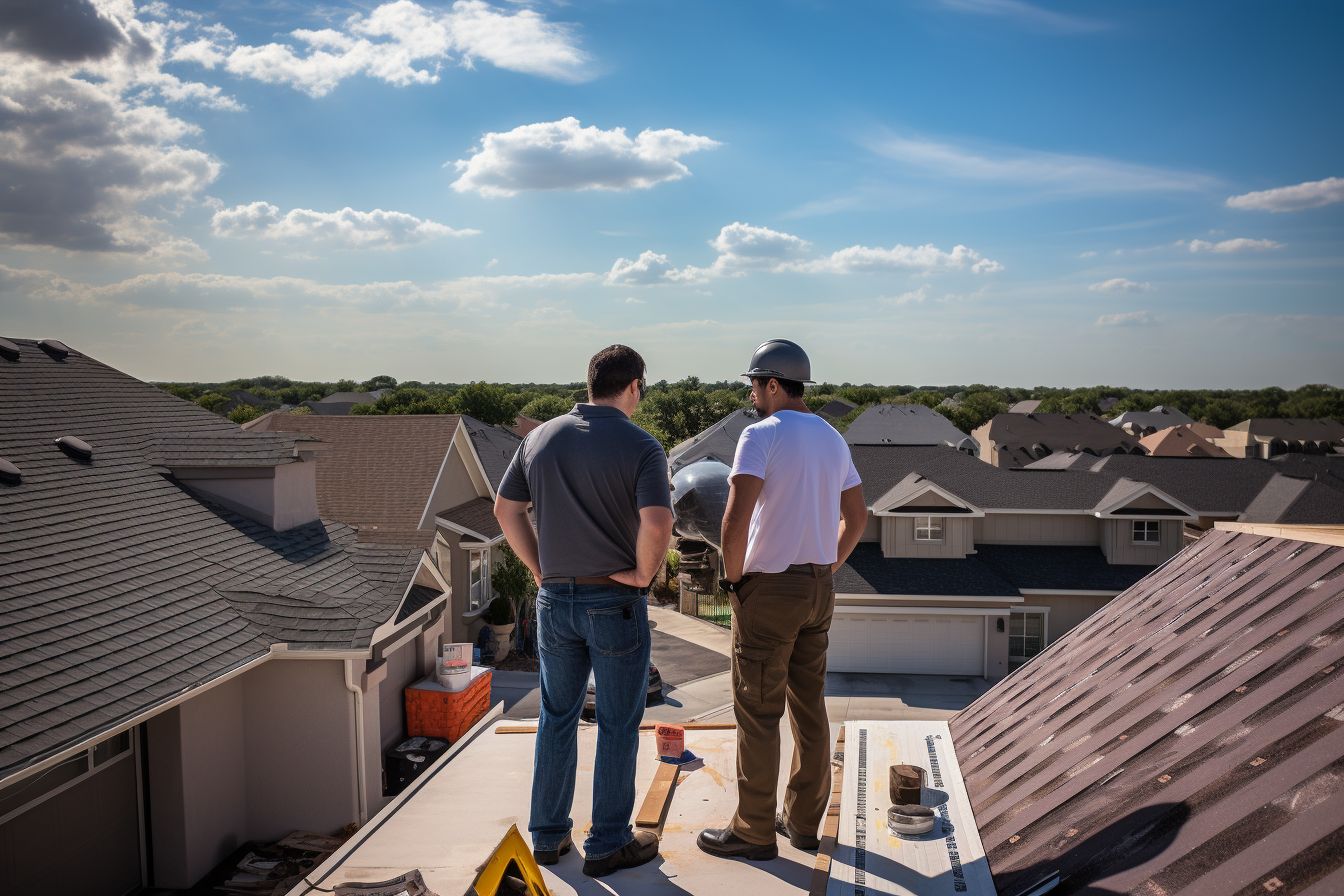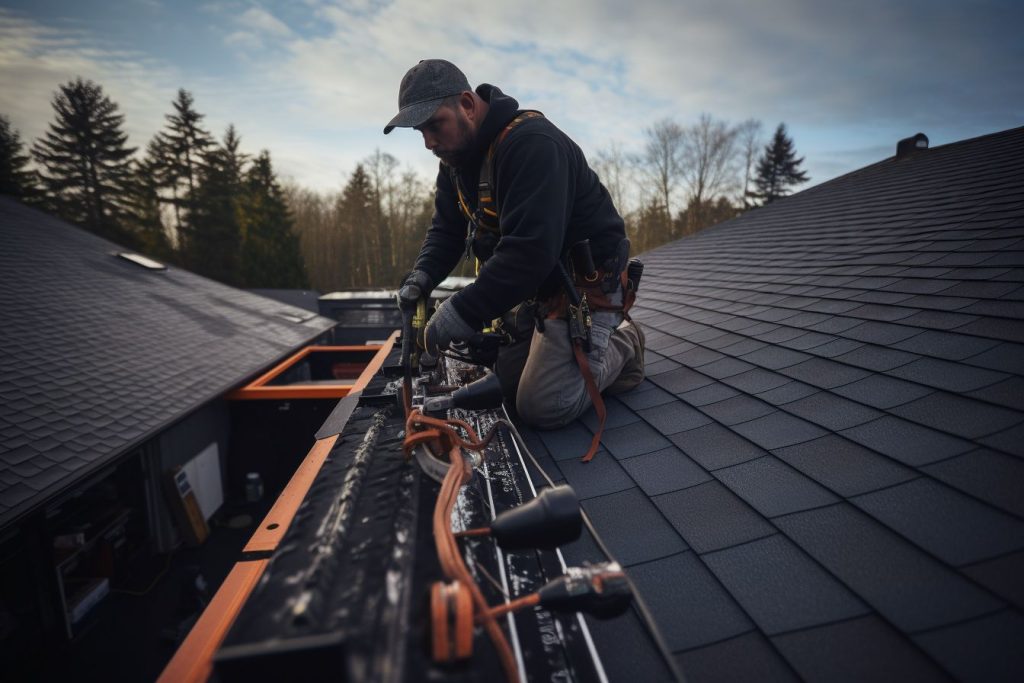Replacing your roof is necessary for the safety of your home, but it can be costly. Did you know that according to Remodeling magazine’s analysis, a midrange roof replacement could cost an average of $20,670? Fear not! This article will guide you on replacing your roof efficiently without breaking the bank.
Ready to save money and still have quality roofing over your head? Let’s dive in!
Key Takeaways
- Signs that indicate the need for a roof replacement include curling edges, cupping tabs, bald spots with missing granules, cracks on shingles, and frequent leaks even after repairs.
- To reduce roof replacement costs, do thorough research on roofing materials and prices, shop around for multiple quotes from contractors, time the replacement correctly (late winter or early spring), utilise insurance coverage if available, consider DIY or partial DIY options such as removing old roofs or installing new shingles yourself or purchasing materials directly from suppliers.
- Financing options utilisinfor a budget-friendly roof replacement include utilizing home insurance coverage, exploring payment plans through the contractor, considering cash-out refinancing or home equity loans, and using credit card payments with low-interest rates or reward points accumulated through usage. Be cautious about overlays, as they may not address underlying issues and could cause further damage in the long run.
Signs that Your Roof Needs to be Replaced

Ageing roofs, especially those 20 to 30 years old, often show telltale signs that indicate the need for a replacement. Please be on the lookout for shingle issues like curling edges and cupping tabs, which can become problematic over time.
Additionally, keep an eye out for bald spots where granules are missing and cracks on the surface of the shingles – these are clear warning signals that your roof may require immediate attention.
Ignoring these signs might lead to more severe problems such as leaks or structural damage. Aside from surface warnings, performance issues like frequent leaks, even after repairs, can also be a red flag.
Understandably, roof replacement is an essential task homeowners will eventually face. So when you come across any of these symptoms, ensure to act promptly; remember,, avoiding timely action could end up costing more in long-term damages.
A Detailed Guide to Reducing Roof Replacement Costs

To reduce roof replacement costs, it is important to do thorough research and shop around for the best prices and deals.
Do your research and shop around.
Exploring different options could make a significant difference in your roof replacement costs. Start by doing thorough research on various roofing materials and their prices. Understand the pros and cons of each to determine which one will offer both durability and affordability.
Remember, durable materials can save you from frequent replacements, thus lowering your long-term expenses.
Take your time settling for the first roofing contractor you find; shop around instead. Seek multiple quotes to compare, ensuring that cost-effective solutions don’t come at the expense of quality artistry.
Look out for any special offers or deals contractors might have during specific periods. This strategy combines informed decision-making with comparison shopping to find money-saving opportunities in an otherwise expensive project.
Time the replacement right
Planning the timing for roof replacement can significantly slash roofing expenses. Late spring to early fall typically marks the busiest season for most roofing companies, leading to higher prices due to demand.
Thus, scheduling your project in late winter or early spring could result in cheaper estimates and faster installation times. However, keep a close eye on weather forecasts as harsh conditions might delay work progress.
The average lifespan of a roof ranges between 15 to 30 years, but waiting too long may cause further damage and increase costs. Regular roof maintenance helps extend its life while promptly identifying potential trouble spots that need repair can prevent complete replacements and save money.
Utilise insurance coverage
Most homeowners insurance policies provide coverage for roof replacement, which can significantly reduce overall costs. Insurance coverage for roofs typically includes damage caused by storms or accidents.
It’s important to note that the coverage may be limited to the actual cash value (ACV) or the replacement cost value of the roof. Older roofs may only be insured for their ACV, so it’s essential to understand your policy’s limitations.
By utilising insurance coverage, you can use this financial protection and minimise your out-of-pocket expenses when replacing your roof.
Consider DIY or partial DIY options.
Save money on your roof replacement by considering these cost-effective alternatives:
- Take on the project yourself or hire a professional for certain tasks, like removing the old roof or installing new shingles.
- Research and learn about the necessary skills and tools for DIY roof replacement to ensure success.
- Purchase materials directly from suppliers to cut down on costs.
- Compare prices from different contractors to find the most affordable option.
- Take advantage of discounts or promotions offered by roofing companies.
- Seek advice from experienced DIYers or consult online tutorials for guidance.
- Be aware of any building codes or permits required before starting the project.
Explore financing options
Exploring financing options is a crucial aspect of managing the costs of a roof replacement project. This involves assessing various monetary sources that can help you cover the expenditure.
| Financing Option | Description | Advantages |
|---|---|---|
| Home Insurance Policy Coverage | Check if your home insurance policy covers roof replacements and to what extent. Some policies may cover the entire cost if the damage is from a natural disaster or accident. | It helps to minimise out-of-pocket costs. Ensures a smooth roof replacement process. |
| Payment Plans Through the Contractor | Some roofing contractors offer payment plans, allowing you to spread the payment over a certain period. | Allows manageable installments—no need for an upfront lump sum payment. |
| Cash-out Refinancing or Home Equity Loan | You can refinance your mortgage or take out a home equity loan to fund your roof replacement—lower | r interest rates compared to credit cards. Allows investment back into your property credit |
| t Card Payment | If manageable, using a credit card to pay for the roof replacement can be an option, particularly if you have a card with a low-interest rate or reward points. | Immediate access to funds. Potential to earn reward points. |
| Government Loans | Government offers specific loans for home improvements, including roof replacements. | Lower interest rates. Flexible repayment terms. |
Exploring these financing options allows you to assess the most affordable and convenient ways to fund your roof replacement project. Remember, each option has pros and cons – so make a choice that best aligns with your financial situation.
Be cautious with overlays.
When considering roof replacement on a budget, homeowners may come across the option of overlays. An overlay involves installing new shingles on top of existing ones, seem like an affordable alternative, they may not address underlying issues with the roof and could potentially lowering costs and savingtime.
However, it is important to exercise caution with overlays. While they may seem like an affordable alternative, they may not address underlying issues with the roof and could potentially cause further damage in the long run.
Before opting for an overlay, homeowners should carefully assess the condition of their existing roof and consider consulting with a roofing professional to ensure that this option is suitable for their specific situation.
Hiring a Professional Roofer vs. DIY Replacement

Making the choice between hiring a professional roofer and opting for a DIY replacement involves careful consideration. Here’s a comparative analysis.
| Professional Roofer | DIY Replacement | |
|---|---|---|
| Quality | Professional roofers provide high-quality work, as mentioned in Fact 2. They have the expertise and equipment needed for an efficient job (Fact 5). | DIY replacements may not maintain the same quality due to lack of experience and proper tools. |
| Cost | Engaging professional roofers might be costlier initially. However, their work can lead to better long-term results, reducing future expenses (Fact 8). | DIY replacements can be cheaper upfront (Fact 1). Yet, it might lead to future costs if not properly executed. |
| Risks | Professional roofers minimize risks of further damage, ensuring proper installation (Fact 2). | DIY replacements pose a risk of causing further damage to the roof and the rest of the structure (Fact 3). |
| Skill Level | Reputable roofers have the necessary skill level to deal with several roofing issues (Fact 6). | DIY approach requires a noteworthy level of skill, which might not be present in all homeowners. |
The decision should be based on factors like budget, aptitude for DIY projects, and the severity of roof issues.
Options for Financing a Roof Replacement on a Budget
There are several options available for financing a roof replacement on a budget, including utilizing homeowners insurance coverage, exploring payment plans through the contractor, considering cash-out refinancing or home equity loans, or even using credit card payments.
Home insurance policy coverage
Most homeowners insurance policies provide coverage for roof replacement if it is damaged by a storm or accident. This means that if your roof is affected by severe weather conditions, such as strong winds or hail, or if there is accidental damage caused by falling tree branches, your insurance may cover the cost of replacing the roof.
However, it’s important to note that home insurance typically does not cover roof replacement due to wear and tear over time. Additionally, the extent of coverage may vary depending on your specific policy and terms.
Therefore, it’s vital to review your home insurance policy carefully to understand what types of damage are covered and how much the insurance company will pay towards a roof replacement.
Payment plans through the contractor
Payment plans through the contractor offer homeowners an affordable financing option for their roof replacement. These plans allow homeowners to pay off the cost over time, making it easier to manage their budget.
Some contractors even provide payment plans with low monthly payments, ensuring that homeowners can finance their roof replacement without straining their finances. Prequalification options may be available, allowing homeowners to secure financing with no money down.
This makes payment plans through the contractor a flexible and manageable option for those on a budget.
Cash-out refinancing or home equity loan
Cash-out refinancing and home equity loans are two options for homeowners looking to finance a roof replacement on a budget. Cash-out refinancing involves replacing your current mortgage with a larger loan in order to access the equity you have built up in your home.
This can provide the funds needed for a new roof while potentially lowering your monthly payments. On the other hand, a home equity loan allows you to borrow against the value of your home, using it as collateral.
Both options offer opportunities to use the cash from your home to fund your roofing project without breaking the bank.
Credit card payment
Credit card payment is a convenient financing option for roof replacement on a budget. With this option, you can pay for your new roof over time rather than upfront. Applying for credit card financing is easy, and some roofing companies even offer their own payment plans through credit cards.
However, it’s important to note that credit card financing may come with higher interest rates compared to other options. Nonetheless, if managing the upfront cost of a roof replacement is a concern, using a credit card allows you to spread out the payments while still getting the job done.
Conclusion

Replacing a roof on a budget is possible with careful planning and research. By obtaining estimates, exploring financing options, and considering DIY or partial DIY alternatives, homeowners can reduce the cost of roof replacement.
It’s important to remember that working with a reputable roofing contractor can also help ensure a budget-friendly and successful project.
FAQs
1. Can I replace a roof on a budget without hiring professionals?
Yes, it is possible to replace a roof on a budget by doing the work yourself or with the help of friends and family. However, keep in mind that roofing can be dangerous and requires proper knowledge and safety precautions.
2. How much does it cost to replace a roof on a budget?
The cost of replacing a roof on a budget will vary depending on factors such as the size of your roof, materials used, and any additional repairs needed. It’s best to gather quotes from different suppliers and contractors to get an accurate estimate.
3. Are there any affordable roofing materials available for replacing my roof?
Yes, there are affordable roofing materials available for replacing your roof, such as asphalt shingles or metal sheets. These options offer durability while being cost-effective compared to premium materials like slate or tile.
4. What are some tips for replacing a roof on a tight budget?
Some tips for replacing a roof on a tight budget include shopping around for the best prices on materials, considering DIY installation if you have experience, prioritizing essential repairs over cosmetic upgrades, and exploring financing options if necessary.

